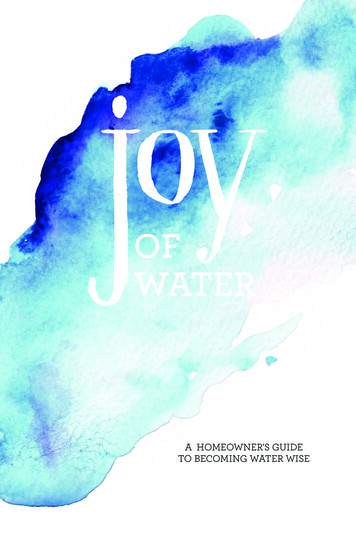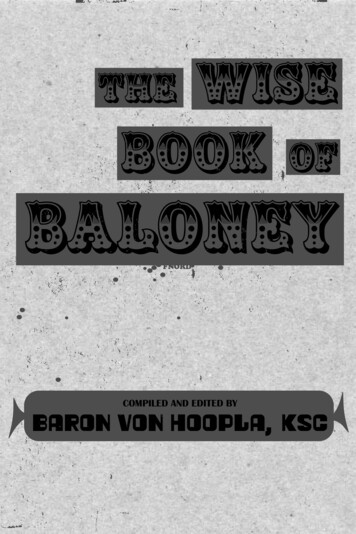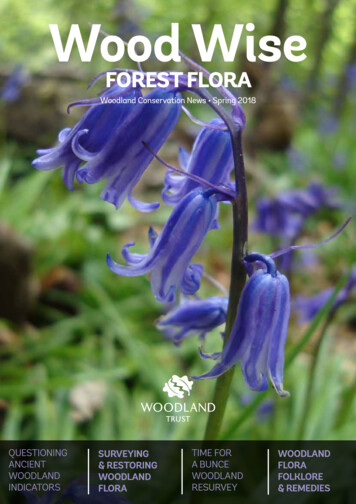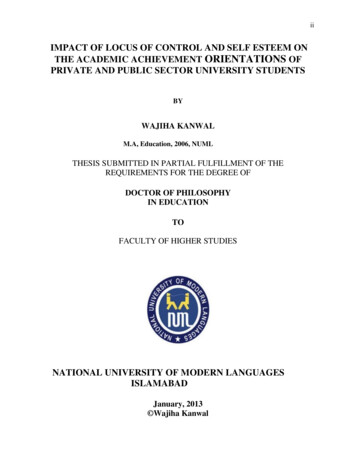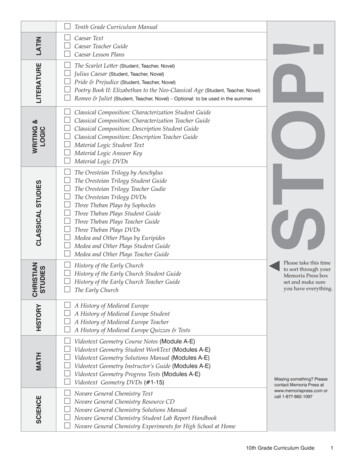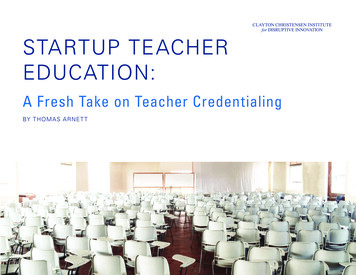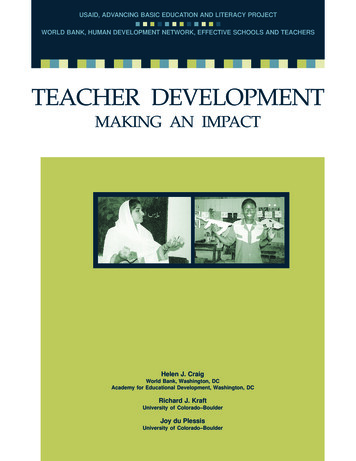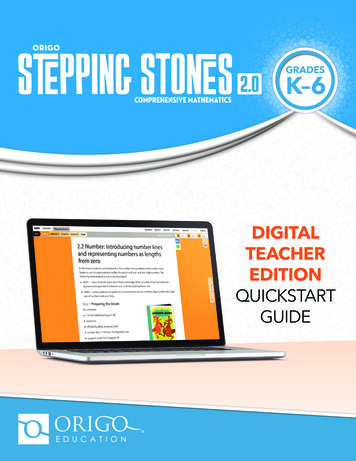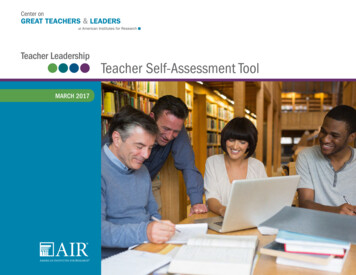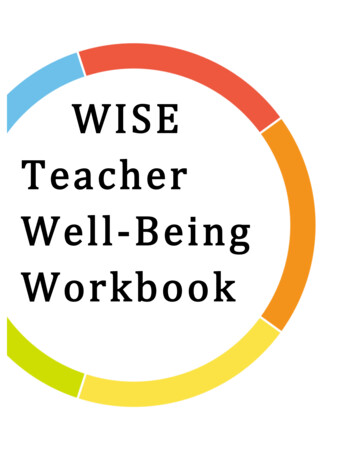
Transcription
WISETeacherWell-BeingWorkbook
2WISE Teacher Well-Being WorkbookWISETeacherWell-BeingWorkbookThe Wellbeing In School Environments (WISE) Workbook is to help you develop your own personal well-beingplan. It was written for teachers, educators, and those working in schools, but can be useful to others such asstudents. It is not to be read through all in one sitting, or even necessarily in the order of the chapters here.Read the first chapter to get oriented about well-being, and how the materials and topics fit together.You may prefer to skip around after Chapter 1, since some of the content will be more important to you atdifferent times.Each chapter will focus on important components of well-being, such as physical, occupational, intellectual,social, or emotional well-being. Effective skills and tools for each component are then provided for you toconsider to enhance your own well-being.There are measures for you to use at the beginning of each chapter to help you identify your strengths andopportunities to enhance your well-being. It is most productive for you to complete these measures before youproceed to the skills/tools described later in each chapter. These measures help identify your unique patternsand preferences so that you can tailor the chapter to you and areas specific for your unique skill set. Eachchapter concludes with a one-page summary SKILL GUIDELINES to help you review and incorporate the mostimportant components of that chapter in your well-being plan. You may wish to review these SKILLGUIDELINES frequently as you refine your well-being plan. At the end of each chapter, you can identify theparticular strategies you most wish to implement in your own life, and also in your classroom/school.Copyright 2019 J. Bostic; workbook materials may be freely used but not sold or for profit
3Copyright 2019 J. BosticCorresponding Author:Jeff Bostic, MD, EdDChild Psychiatry DivisionMedStar Georgetown University HospitalWashington, DCContributors:Neal Horen, PhDChild Psychiatry DivisionEarly Childhood Intervention NetworkMedStar Georgetown University HospitalWashington, DCSharon Hoover, PhDNational Center for School Mental HealthUniversity of Maryland School of MedicineBaltimore, MDNancy Lever, MDNational Center for School Mental HealthUniversity of Maryland School of MedicineBaltimore, MDMatthew Biel, MD, MPHChild Psychiatry DivisionEarly Childhood Intervention NetworkMedStar Georgetown University HospitalWashington, DCMany have participated in the development of this workbook, and we wish to acknowledge the helpfulcontent contributions of Brooke Buerkle James (Relay Teacher Training), Kate Frelinger, MD (MedStarGeorgetown University Hospital). In addition, we are most grateful to many teachers at Relay and Teachfor America have received this material and provided valuable input.We are also grateful for assistance with formatting assistance from Kerri Frank, Leslie Roeser, andNathan Blumberg (MedStar Georgetown University Hospital).For any Inquiries about this Workbook, please contact Jeff Bostic at:MGUH Department of Psychiatry2115 Wisconsin Ave, NWSuite 200Washington, DC 2000Email: Jeffrey.q.bostic@gunet.georgetown.eduCopyright 2019 J. Bostic; workbook materials may be freely used but not sold or for profit
4WISE Teacher Well-Being WorkbookTable of Contents1. Be Well . 7The Teacher Well-Being Wheel Activity .10Making Changes (Even Good Ones) .13Making Changes in Your Life.15Change Plan Worksheet .16Goal-Setting (SMART Goals) .17SKILL GUIDELINES: Goal-Setting .192. Emotional Well-Being: Coping With Stress .21A little stress is good. A lot, not so much. .22PULLIS STRESS INVENTORY (Adapted for Teachers) .23Stress Symptoms Checklist .25Positive Ways of Working Through Stress .28Coping Responses .30My Positive Coping with Stress Approach .33My Adverse Childhood Experiences (ACES) .35My Adverse Teacher Experiences (ATES) . 37SKILL GUIDELINES: Positive Ways of Coping with Stress .383. Emotional Well-Being: Managing Emotions .39Emotions .39Therapeutic Approaches Applied to Well-being .48Practicing My HARPS .51Thinking Traps . 43Hope .58The Future Scale .59Interpreting The Future Scale .60My Mood Review .61SKILL GUIDELINES: .62Managing Emotions .624. Emotional Well-Being: Mindfulness .63Mindfulness .63Mindfulness Activities .65SKILL GUIDELINES: .69Mindfulness Practices .69Copyright 2019 J. Bostic; workbook materials may be freely used but not sold or for profit
55. Physical Well-Being: Sleep & Nutrition .70Sleep .71Sleep in Adults .72Insomnia .74Nutrition .75My Daily Food Preferences .75Managing Appetites Through Healthy Nutritional Practices.80My Healthy Lifestyle Preferences Plan: Sleep & Nutrition .82SKILL GUIDELINES: .83Sleep & Nutrition .836. Physical Well-Being: Physical Activity and Music .85My Weekly Activity Preferences .86Physical Activity .87My Healthy Lifestyles Plan: Physical Activity .88Music .89My Healthy Lifestyles Plan: Music .92SKILL GUIDELINES: .93My Healthy Lifestyle Preferences Plan: .93Activity & Music .937. Social Well-Being: Relationships .94The Importance of Social Relationships .94My Friendship Profile (MFP) .95My Humor Style .99Gratefulness . 101SKILL GUIDELINES: . 102Social Engagement . 1028. Social Well-Being: Managing Conflicts . 103Speaking With Others . 105Active Responding. 106Using Your OARS . 110Triggers . 112My Friendship Triggers . 113My Trigger Activity Worksheet . 115SKILL GUIDELINES: . 116Managing Conflicts . 116Copyright 2019 J. Bostic; workbook materials may be freely used but not sold or for profit
6WISE Teacher Well-Being Workbook9. Occupational Well-Being: Time Management & Budgeting . 117My Time Management Practices . 118Effective Time Management. 120Example Activity Log . 123Time Management Strategies. 125Overcoming Procrastination . 128SKILL GUIDELINES: . 130Effective Time Management. 13010. Intellectual Well-Being: Meaningfulness . 131My Meaning .132My Spirituality . .134The Hours Of My Life . 137SKILL GUIDELINES: . 140Making Meaning In One’s Life . 140References . 141Copyright 2019 J. Bostic; workbook materials may be freely used but not sold or for profit
71. Be WellLearning Objectives (After completing this chapter you will be able to):1.2.3.4.Recognize three impacts of your well-being on your professional effectivenessIdentify your well-being in five categoriesDescribe the “stages of change” model and decide which stage best fits youDescribe three effective tactics to help make life changesSkills you will develop through this chapter:A. How to manage obstacles to changeB. How to make your Well-Being PlanOpening Activity – Looking Back and Looking ForwardConsider your path to becoming a teacher. Think back to the experiences that come to mind when you thinkabout your schooling. Use all your senses as you recall the sights, smells, sounds during those moments.Recall how your body felt and what emotions you felt during those experiences. Think about the exact momentwhen you realized you wanted to become a teacher and how all those sensations impacted you. Considerwhat you want to take from teachers from your past, and how you want to make schooling better for studentswith your unique talents.Begin with the end in mind:1)What Impact Do You Most Wish to Have on Your Students?2)What Do You Hope Students Will Remember About You?What is Well-Being?“Well-being” has broadened the term “wellness,” which referred to one’s physical health, to include additionalcomponents or dimensions of positive health. There is no current agreed-on definition of well-being, as itcontinues to evolve, with anywhere from 5-8 components or dimensions of well-being now described. Forexample, SAMSHA identifies “wellness” components now to include physical, emotional, social, occupational,intellectual, environmental, financial, and spiritual.Significant cultural differences influence well-being, as different components of well-being may receive moreemphasis in different cultures, and as the values and specific tasks and aspirations within each componentmay be defined quite differently. For example, cultural variations abound in how one should take care of one’sbody, how to manage emotions (e.g., express vs. restrain), the relative importance of independence vs.interdependence (or personal success vs. contributing to the greater good), what roles/careers are mostvalued and sought, and what yields meaning in life (achievements vs. caring for family, etc.).This workbook will focus on five components of well-being:1) Physical health (nutrition, sleep, healthy activities such as exercise and music, sleep)2) Occupational health (creating positive life roles and career)3) Intellectual health (continuing to grow, flourish, and find meaning as one’s life progresses)4) Social health (creating positive social relationships and having positive social encounters)5) Emotional health (feeling positive emotions and managing distressing emotions effectively)Copyright 2019 J. Bostic; workbook materials may be freely used but not sold or for profit
8WISE Teacher Well-Being WorkbookThis workbook will address each of these 5 broad components of well-being as applied to teachers, withspecific measures of each component for you to take to assess your well-being in that domain, and thenspecific tactics to enhance each of these 5 areas.Many factors contribute to teacher well-being, including the organizational culture and climate of a school,available supports and resources, demands placed on teachers, and the relationships between schoolleadership and teachers. This workbook focuses on those factors over which you have more influence, but wealso recommend considering ways to assess and improve other factors that contribute to well-being, whenpossible.Well-Being Matters (Why is Well-Being Important?)Being well improves our lives both at work and at home. Good well-being optimizes our ability to be fullyengaged in our classrooms and to deliver the teaching skills we worked to develop. Being well at workimproves our well-being at home, and vice versa.Using well-being skills allows us to better respond to stress and adversity. Teaching is an intense, taxingprofession. About 20-30 kids per hour will be looking to you for direction, inspiration, support and interventionwhen trouble arises, which can be draining at times. Teachers who report greater stress find it more difficult tooffer praise and nurturance to students, and are less productive at work. Preparing for adversity with strongwell-being allows us the flexibility and resilience to respond to the stress and challenges inherent to teaching.4Finally, when we model and teach well-being in our classrooms, we are equipping students with well-beingskills to improve their current and future lives.We’ll look at the 5 spheres of well-being: (1) Physical, (2) Occupational, (3) Intellectual, (4) Social, and (5)Emotional. To help identify your well being in each of these areas, complete The Poise Well-Being SelfAssessment. If you prefer to color rather than circle (quantify) your answers, you can complete the alternativeactivity: The Well-being Wheel activity (on the following page). As you complete the POISE or the Well-BeingWheel, please remember: Each person is unique. There is no right or wrong wheel. Responses will vary depending on your experiences and stage of lifeCopyright 2019 J. Bostic; workbook materials may be freely used but not sold or for profit
9Name (first, middle, Initial of last name): Date:POISE Well-Being Self-Assessment ScalePlease circle the best answer for each item (focusing on the past 2 weeks), with 1 not at all, 2 a little,3 moderately, 4 mostly, and 5 almost always.1. I enjoy uninterrupted restful sleep for 6 hours most nights.2. I eat and enjoy nutritious foods and how they make me feel.3. Most days I exercise/physically move for 30 minutes (7000 steps).4. I move about so I’m not sedentary or sitting for more than 1 hourat a time during the work day.5. Music and/or artistic activities are a regular enjoyable part of my life.11112222333344445555123456. My work fulfills my sense of purpose.7. I stay focused and present when I do my job.8. I manage my time well and complete most tasks on time.9. I am able to achieve my goals despite obstacles that occur.10. I am not easily discouraged by failure.111112222233333444445555511. I like to stimulate my mind by doing activities such as reading,listening, or watching.12. I like to explore my interests more deeply or improve my skillset.13. I seek or think of better ways to do things.14. I journal, write (e.g., poetry or music), or capture pictures andvideos of my life story.15. I rely on deeply held principles or spiritual values to guide my life.123451112223334445551234516. I have a strong and reliable network of supportive others at work.17. I seek input and feedback from others.18. I am aware of what annoys me, and I am aware of what I do thatannoys others.19. I support others and acknowledge their successes.20. I am able to resolve conflicts in most areas of my life111222333444555112233445521. I can stay with and tolerate my painful emotions and learn from them.22. I feel calm or serene most of the time.23. I have developed reliable, effective ways to cope with stress.24. I can manage my emotions to stay on task or work when necessary.25. I enjoy living in the present and worry little about the past or future.1111122222333334444455555Copyright 2019 J. Bostic; workbook materials may be freely used but not sold or for profit
10WISE Teacher Well-Being WorkbookThe Teacher Well-Being Wheel ActivityFor each statement below, fill in the corresponding pie-shaped section of the wheel to reflect the degree towhich the statement relates to you. For example, if you enjoy uninterrupted restful sleep most nights (item 1)about half the time, you can color 50% of that section; if you sleep well all the time, then you can color 100% ofthe section, etc. Use a different color for each section (set of 5 items) of statements if possible.1.2.3.4.5.I enjoy uninterrupted restful sleep for a similar interval most nights.I am proud of what I eat and its nutritional value.I look forward every day to some recreational physical activity.I try to move about so I’m not sedentary or sitting for more than one hour at a time.Music and/or artistic activities are an enjoyable, regular part of my life.6.7.8.9.10.I enjoy my work and what it requires of me.I stay focused and present when I do my job.I manage my time well and complete most tasks on time.I continue to grow and flourish in my job.I am proud of my career.11.12.13.14.15.I like to stimulate my mind by doing activities such as reading, listening, or watching.I like to explore my interests more deeply or improve my skillset.I seek or think of better ways to do things.I journal, write (e.g., poetry or music), or capture pictures and videos of my life story.I rely on deeply held principles or spiritual values to guide my life.16.17.18.19.20.I am able to engage with and enjoy others, including those unlike me.I regularly seek input from good friends, even if they’re not in close proximity.I am aware of what annoys me, and I am aware of which of my actions may bother others.I am able to set and respect my own and others’ boundaries.I am able to resolve conflicts in most areas of my life.21.22.23.24.25.I value all the different emotions I feel.I feel calm or serene most of the time.I can stay with and tolerate my painful emotions and learn from them.I can manage my emotions and stay on task or work when necessary.I enjoy living in the present and worry little about the past or future.After completing the wheel, examine your overall POISE level. Which general components are you doingwell in (most colored in)? Which specific areas do you wish to improve upon (least colored in areas)?Copyright 2019 J. Bostic; workbook materials may be freely used but not sold or for profit
11My Teacher Well-Being pyright 2019 J. Bostic; workbook materials may be freely used but not sold or for profit
12WISE Teacher Well-Being WorkbookWe will provide you steps and strategies to develop each of the 25 spokes of the wheel within each of the 5well-being areas. Below is a summary of the topics we will address:i. Physical (Sleep, Exercise, and Nutrition) Getting Restful, Rejuvenating SleepDeveloping a Healthy DietGetting Healthy Exercise; Living a Non-sedentary lifeDeveloping Artful Activities of Daily Livingii. Occupational (Satisfaction & Rewards of Job and Budgeting) Configuring Your Job EffectivelyManaging Your Time EffectivelyOvercoming Procrastinationiii. Intellectual (Doing What Matters and Has Meaning; Exploring Life Opportunities) Finding Meaning in Daily LifeMy MeaningMy SpiritualityComparing What I Do with My Time to What I Value Doing During this Lifeiv. Social (Positive Relationships and Getting Along Well with Others) Sustaining Good RelationshipsUsing OARS (to engage others in deeper conversations)Managing and Deescalating ConflictIdentifying My Friendship TriggersIdentifying My Humor StyleIdentifying My Classroom Triggersv. Emotional (Experiencing Desired Emotions and Managing Difficult Feelings) Coping with StressMindfulness Based Stress Reduction (MSBR)The Future Scale (Hope)Effective interventions will be provided for you to choose from, which will allow you to test what bestimproves your well-being in each area. At the end of each chapter, suggestions for how to extend this fromyour personal life and into the classroom will also be provided; you may find that some skills are appropriatefor your students, so recommendations for classroom teaching of these skills is provided in Part II.Over the course of a school year, certain areas may become more or less important to you. Knowthat it is normal and appropriate to skip around, and return to, these chapters based on your unique,changing needs at any time over a school year.Before you proceed with other chapters, it’s helpful to know what the science says about making changes inone’s life. The next section addresses how people make life changes, and what tactics are most effective formaking changes that last.Copyright 2019 J. Bostic; workbook materials may be freely used but not sold or for profit
13Making Changes (Even Good Ones)You may have identified areas that you wish to improve. Just know that change can be more difficult than itseems. Often, we realize how to make improvements, but our real desire to make such a change is notstrong enough to motivate us to stick with that change. In addition, there can be obstacles to make changesthat keep us from doing what we plan to do.Consider the following examples from someone contemplating changes in activity or nutrition:“I want to exercise more often. But I find that when I get home that I’m tired. I unwind by watching some TV,and then it’s really hard to get up, change into workout clothes and go workout at 8:30 p.m.”“I want to eat more fruits and vegetables. So I bought several kinds of fruit, but (a) it was expensive, (b) thetime it took to peel and cut it up was frustrating, and (c) it wasn’t satisfying—I didn’t really like eating it verymuch so it went bad and I felt
This workbook will focus on five components of well-being: 1) Physical health (nutrition, sleep, healthy activities such as exercise and music, sleep) 2) Occupational health (creating positive life roles and career)

